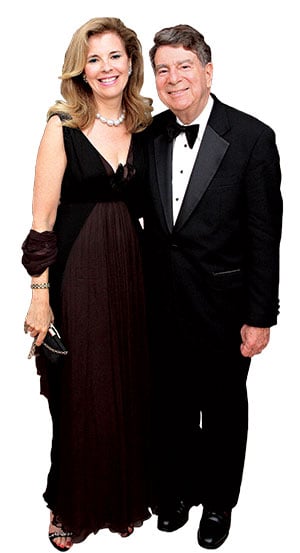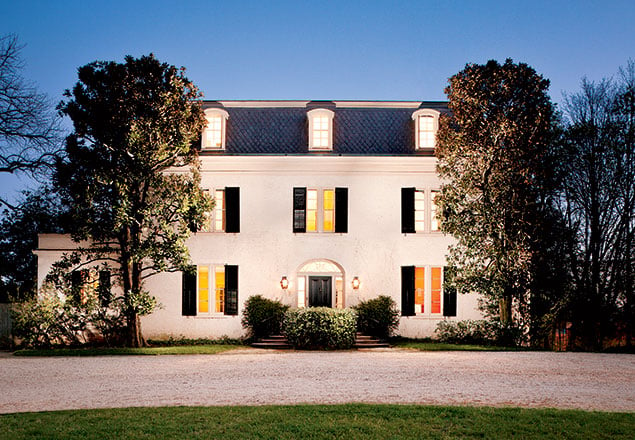There was a time, not so long ago in fact, when venture capitalist Mark Ein and developers and philanthropists Jane and Calvin Cafritz were nothing but friendly with each other. The next-door neighbors own two of the grandest homes in Georgetown and used to hobnob at gatherings open only to a certain slice of Washington society. When Ein got married, he had the Cafritzes over to his home for the wedding and reception. Every September, the Cafritzes invited Ein to their end-of-summer soiree welcoming the city’s elite back from their assorted travels and beach homes. The houses share part of a driveway, and Ein always let the Cafritzes’ guests park on his side.
These days, however, the neighbors aren’t even speaking. Since June, they’ve been locked in a fence-line feud that has so far involved hours of public testimony, scores of architectural renderings, $500,000 in expenses, one not-so-accidental shoulder bump at an Old Georgetown Board meeting, and some good armchair anthropology about the cultural significance of the property in question: the former home of Katharine Graham.
• • •

In the second half of the 20th century, 2920 R Street—once owned by George Washington’s great-grandnephew and later by William “Wild Bill” Donovan, founder of the agency that preceded the CIA—was the hub of Washington’s social life, its horseshoe-shaped driveway clogged with political and social luminaries who ate terrapin soup off Kay Graham’s George III dining tables. Beyond burnishing the legendary Washington Post publisher’s influence, the gatherings helped establish Georgetown as the town’s center of political power.
Now, though, the property has been empty for 13 years—and the jousting has less to do with geopolitics than with neighborhood politics. Which doesn’t mean the personalities are any less forceful. In fact, it might mean just the opposite.
In one corner: Ein, owner of the Washington Kastles and an alum of Goldman Sachs and the Carlyle Group. The moment he walked into the Graham home for the first time back in 2001, he was sold. The cream-colored mansion sits on more than an acre and has the feel of a country estate. But like a lot of people who buy a glorious old property, Ein now wants to make a few changes. “We’re literally just trying to turn an old house into a family home for the 21st century,” he says.
In the other corner: Calvin Cafritz, son of a DC property-development mogul, and Jane Cafritz, an attorney. Calvin bought his home back in the early 1970s. He’d spent 2½ years negotiating for the privilege of residing next door to Mrs. Graham. From the couple’s vantage—maybe 25 feet away—Ein’s proposed additions are a blight. “I think they want new zoning laws just for them,” Jane Cafritz says. “Like they’re special.”
From afar, the fight over the Graham house could look like a grand battle, freighted with symbolic meaning: the old Washington of power and influence versus the new one of money and entrepreneurialism. Or perhaps the old economy of office development versus the new one of tech. Or the quiet and tasteful Georgetown of old versus an upscaled, suburban mode of living.
Spend enough time following the story, though, and it looks a lot more simple: an old-fashioned catfight between two very bright, deep-pocketed adversaries. In a way, that makes it an even more interesting sign of the times.
• • •
Ein bought the estate in 2002 for $8 million. Still single, he didn’t move in. But last year, he ended his long run as a leading Washington bachelor and married Sally Stiebel, a policy analyst two decades his junior. The newlyweds wanted to have children and decided to make their home in the mansion.
The 230-year-old house needed work. The kitchen, circa 1915, was too narrow for their taste. There was no covered parking near the house. And the layout was better suited to Graham’s four-course affairs than to hanging out as a family.
Ein’s architects proposed a two-story addition with a wider kitchen and kids’ bedrooms. There would be a family-room addition out back, a gym in the basement, and two garages—one for each side of the front door. “Our experts”—a firm imported from New York and paired up with the Georgetown architect Outerbridge Horsey—“really believed that this was something that was going to be well received,” Ein says.

Before construction could begin, he had to pitch the plans to the Old Georgetown Board, a federal panel that reviews changes to historic properties. Ein made the rounds of local officials and gave tours to residents in hopes of smoothing the way. “He came in as someone who was intending to be a good neighbor,” says Tom Pursley, a retired government lawyer who has lived in Georgetown for 26 years, “and concerned about doing something that the neighbors would approve of.”
The Eins also walked across the driveway to show the Cafritzes the drawings. It did not go well. And because they’re experts in real estate, the Cafritzes knew how to frame their displeasure.
In a letter to the Old Georgetown Board, Jane Cafritz laid out the specific grievances: Ein’s addition would creep within eight feet of the property line, threatening the Cafritzes’ “feeling of openness.” The construction would block their “dappled afternoon light.” And the digging would cause “irreparable damage” to the couple’s 100-year-old bald-cypress and 80-year-old Osage-orange trees. (For good measure, she also mentioned a row of marigolds on Ein’s property.)
There was something even more sinister about that pair of garages. As Jane says, they were “a little too”—here she drops her voice to a whisper—“suburban.”
• • •
Before long, Ein had to scrap the above-ground garages—a “nonstarter” in the eyes of the board—and draw up several sets of new plans. But although support from the community was overwhelming and a neighborhood commissioner called one of the revisions “a home run,” he still didn’t win over the Cafritzes. In fact, they couldn’t even agree about the basic history of Ein’s house.
Why did Ein insist on putting his “massive addition,” in Jane’s words, on their side of his home when he had so much unused space out back?
History, he said: Because the back of the house was once its main entrance, putting the extra rooms there would erode the estate’s character.
Revisionist history, the Cafritzes said, after hiring an architectural historian to produce a 46-page investigation concluding that the back of the Graham house had never been the main entrance.
Major construction is a pain in any DC neighborhood—even more so in a historic district like Georgetown. But when the disgruntled next-door neighbors who don’t like your drawings happen to be a supercouple of Washington real estate, even a powerful guy like Ein can feel outmatched. “I went out and hired the best team in the world,” Ein says, “and this has been one of the hardest processes—and probably the most dysfunctional—that I’ve ever been through.”
Ein sympathizers might argue that there was some hypocrisy at work: The Cafritzes had done extensive upgrades to their own old home over the years, including installing a giant window right across from where Ein wanted to add on. They did this without consulting him, according to Ein’s architect, and now it seemed to be their biggest problem with his plans.
A few miles north, the Cafritzes are themselves on the receiving end of complaints that sound awfully similar to the ones they’ve lodged: Their 263-unit apartment-building project at Connecticut Avenue and Military Road has enraged residents of Chevy Chase DC. “Do they have no sense of irony?” complains Peter Gosselin, a neighbor who says the Cafritzes’ building has destroyed trees and will cast a year-round shadow over nearby homes. “Skip the dappled—we’ll take any direct sunlight.”
Charges of hypocrisy, though, don’t win real-estate battles—knowing the system does. Which is why, five months in, the Cafritzes are winning. “If you choose to live in Georgetown, then you have to choose to live by historic-preservation rules,” Jane says. “That’s just life in Georgetown.”
• • •
The feud reached its peak in October. Since it all began, there had been 20-some neighborhood meetings, and Mark Ein was half a million dollars in the hole, with nothing to show for it. Once again, he went before the Old Georgetown Board. “There has been disinformation,” Jane Cafritz announced. “This is lies,” Ein countered.
Then the meeting devolved into a scene you’d expect in the hallways of a high school.
Bob Budic, who was then Ein’s only other outspoken critic (even though Ein endorsed his home-renovation plans in 2011), asked for the microphone, but instead of handing it to him, Outerbridge Horsey, the architect, walked it over to a table on the opposite side of the room. “Come and get it,” Horsey taunted.
Budic launched into a rant, and Ein burst out laughing.
“What’s so funny?” Budic hissed.
Ein grinned.
As Budic walked back to his seat, he tossed his shoulder into Ein’s, the way a varsity jock might “accidentally” bump into a scrawny freshman. That was enough for the Old Georgetown Board chairman, who told the bickering neighbors to take it outside.
One month later, the Cafritzes were still on top. On November 6, the board rebuffed Ein for a fourth time. The addition had to get smaller. His garage, now underground, would have to be better camouflaged. And so it goes. To salvage his home, Ein will have to make yet another pitch to the board in December and who knows how many more after that.
If there’s a loser in all this, it’s Georgetown. The neighborhood had lost most of its social centrality even before Kay Graham’s death. When even an energetic, high-profile newcomer gets tied up in its fussy bureaucracy, it doesn’t help the onetime stomping ground of Kennedys and Bradlees win back a reputation for dynamism. Of course, there’s also a silver lining: The ruckus over the Graham house makes it clear that people think the neighborhood is still worth fighting over.
This article appears in the December 2014 issue of Washingtonian.



![Luke 008[2]-1 - Washingtonian](https://www.washingtonian.com/wp-content/uploads/2017/10/Luke-0082-1-e1509126354184.jpg)

















